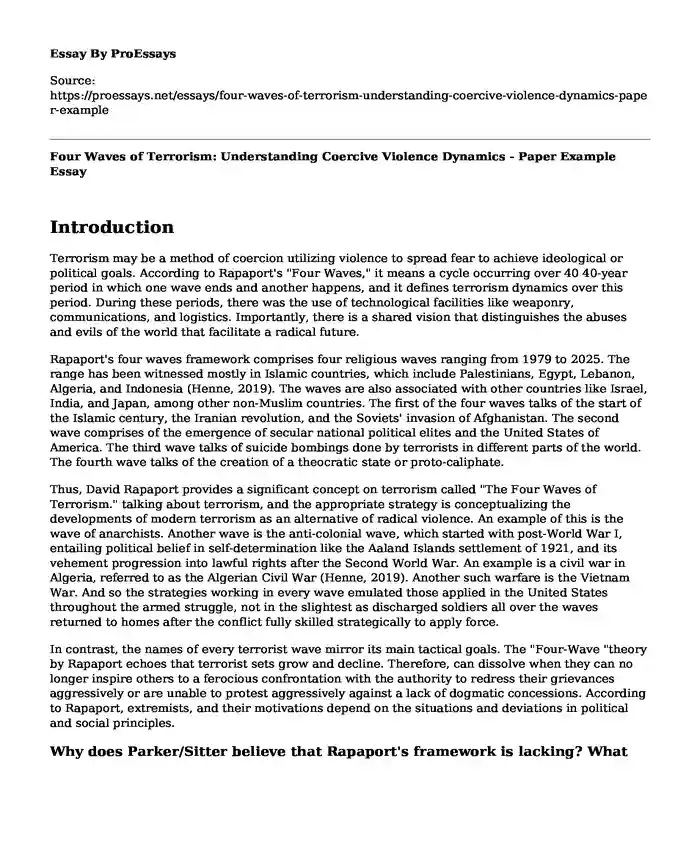Introduction
Terrorism may be a method of coercion utilizing violence to spread fear to achieve ideological or political goals. According to Rapaport's "Four Waves," it means a cycle occurring over 40 40-year period in which one wave ends and another happens, and it defines terrorism dynamics over this period. During these periods, there was the use of technological facilities like weaponry, communications, and logistics. Importantly, there is a shared vision that distinguishes the abuses and evils of the world that facilitate a radical future.
Rapaport's four waves framework comprises four religious waves ranging from 1979 to 2025. The range has been witnessed mostly in Islamic countries, which include Palestinians, Egypt, Lebanon, Algeria, and Indonesia (Henne, 2019). The waves are also associated with other countries like Israel, India, and Japan, among other non-Muslim countries. The first of the four waves talks of the start of the Islamic century, the Iranian revolution, and the Soviets' invasion of Afghanistan. The second wave comprises of the emergence of secular national political elites and the United States of America. The third wave talks of suicide bombings done by terrorists in different parts of the world. The fourth wave talks of the creation of a theocratic state or proto-caliphate.
Thus, David Rapaport provides a significant concept on terrorism called "The Four Waves of Terrorism." talking about terrorism, and the appropriate strategy is conceptualizing the developments of modern terrorism as an alternative of radical violence. An example of this is the wave of anarchists. Another wave is the anti-colonial wave, which started with post-World War I, entailing political belief in self-determination like the Aaland Islands settlement of 1921, and its vehement progression into lawful rights after the Second World War. An example is a civil war in Algeria, referred to as the Algerian Civil War (Henne, 2019). Another such warfare is the Vietnam War. And so the strategies working in every wave emulated those applied in the United States throughout the armed struggle, not in the slightest as discharged soldiers all over the waves returned to homes after the conflict fully skilled strategically to apply force.
In contrast, the names of every terrorist wave mirror its main tactical goals. The "Four-Wave "theory by Rapaport echoes that terrorist sets grow and decline. Therefore, can dissolve when they can no longer inspire others to a ferocious confrontation with the authority to redress their grievances aggressively or are unable to protest aggressively against a lack of dogmatic concessions. According to Rapaport, extremists, and their motivations depend on the situations and deviations in political and social principles.
Why does Parker/Sitter believe that Rapaport's framework is lacking? What specific criticisms do they have?
The two refuse to agree with Rapaport's suggestion that violent terrorists witnessed globally occur in waves. According to them, terrorist activities are motivated by two factors which are; nationalism, socialism, religious extremism, and exclusionism. Besides, they specifically criticize Rapaport's argument that terrorism occurring in faces (Radil & Castan Pinos, 2019). They argue that the motivations mentioned must not be in sequence, but can function alongside each other in motivating various terrorist movements worldwide.
What is Parker/Sitter's alternative framework for analyzing the evolution of modern international terrorism? Be thorough.
Parker and Sitter suggest that terrorism does not always occur in waves. According to them, terrorists are motivated by four goals, which are nationalism, socialism, exclusionism, and spiritual extremism (Radil & Castan Pinos, 2019). Therefore, they argue that the mentioned motivators are not historically progressive, as demonstrated by the Four Waves, where a new wave arises immediately after the proceeding ends. They thus propose an alternative framework for analyzing the development of modern terrorism by suggesting the parallel functioning of these four goals, which are socialism, nationalism, exclusionism, and spiritual extremism overlapping, thereby motivating diverse terrorist activities conferring to their desires.
Which aspects of the two arguments are the most useful in understanding international terrorism? Why?
I find Rapaport's argument to be most helpful in understanding the history of international terrorism. His "Four-Wave" framework contributed a lot to the study of terrorism. It provided a generational model linking current international terrorist groups with their shared features of theology, ideology, tactics, strategy, and future ideas (Radil & Castan Pinos, 2019). Other scientists, like Parker and Sitter, argue that terrorism depends on political reasons and is determined by issues at present. In my understanding, even though Rapaport's argument is focused on current times, starting from the 19th century, it provides a thorough grounding of the background of terrorism, dating from the 1st century. Parker and Sitter also argue that motivators of international terrorism do not have to go in phases, and thus they can function in parallel. The aspects of this argument by these scientists are also beneficial since the reality of modern terrorism is that it does not have to occur in stages. Therefore, I can recommend the ideas from Rapaport, and these scientists need to coexist to give a comprehensive background of international terrorism.
References
Henne, P. (2019). Terrorism and Religion: An Overview. In Oxford Research Encyclopedia of Politics.
Radil, S. M., & Castan Pinos, J. (2019). Reexamining the Four Waves of Modern Terrorism: A Territorial Interpretation. Studies in Conflict & Terrorism, 1-20.
Cite this page
Four Waves of Terrorism: Understanding Coercive Violence Dynamics - Paper Example. (2023, Dec 01). Retrieved from https://proessays.net/essays/four-waves-of-terrorism-understanding-coercive-violence-dynamics-paper-example
If you are the original author of this essay and no longer wish to have it published on the ProEssays website, please click below to request its removal:
- Violent Video Games Discussed
- Importance of Culinary Practices for Syrian Refugees in Egypt
- Essay Sample on Socio-Economic Inequality
- Essay Sample on Equal Rights for Women & LGBTQs: A 19th Century Movement
- Paper Example on Women in Olympics: From 2.2% to a Growing Presence
- Saving Endangered Tigers: Population Decreasing Despite Global Efforts - Essay Sample
- Mental Illness and Homelessness - Free Report Example







